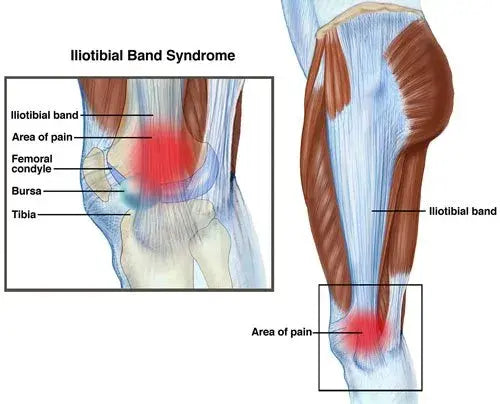
Iliotibial Band Pain and Pain Relief: What You Need to Know
Share
If you’ve ever experienced pain in your outer hip or thigh, chances are you’re familiar with iliotibial (IT) band syndrome or ITBS for short. IT band syndrome is a condition that results when the iliotibial band, a long band of tissue that runs along the outer side of the leg from the hip to the shin, becomes irritated or inflamed. According to the American Academy of Orthopedic Surgeons, IT band syndrome is one of the most common causes of knee pain in runners. However, anyone can develop IT band syndrome, not just runners. If you have ITBS, you may experience pain, tenderness, or stiffness along the outside of your leg and hip. The good news is that there are several things you can do to ease your symptoms and get relief from IT band pain.

Causes of IT Band Syndrome
There are a few different things that can cause IT band syndrome. One common cause is overuse. That’s why this condition is so prevalent in runners; running puts repetitive stress on the IT band, which can lead to irritation and inflammation. Other activities that can cause IT band syndrome include cycling and hiking. People who participate in these activities frequently are more likely to develop IT band syndrome than those who don’t. Additionally, people who have abnormalities in their skeletal alignment or muscle imbalance are also at greater risk for developing IT band syndrome. Poor footwear choices can also contribute to the development of this condition. Wearing shoes that don’t provide enough support or cushioning can put extra stress on the IT band and lead to irritation and inflammation.
Symptoms of IT Band Syndrome
The most common symptom of IT band syndrome is pain along the outside of the leg and hip. This pain is usually worse when exercising—particularly when running downhill or downhill—and it often subsides during periods of rest. Other symptoms may include tenderness along the outside of the leg and hip, stiffness in the affected limb, swelling along the outside of the leg, and weakness in the affected limb. If you experience any of these symptoms, it’s important to see a doctor so they can diagnose your condition and recommend treatment options. Ignoring these symptoms can lead to further damage and longer-term problems.

Treatment Options for IT Band Syndrome
There are several things you can do to ease your symptoms and get relief from IT band pain. First and foremost, it’s important to rest your body and give your legs a break from strenuous activity—this will help reduce inflammation and give your body time to heal itself. Additionally, applying ice to the affected area for 20 minutes at a time several times a day can help reduce swelling and pain. Over-the-counter anti-inflammatory medication such as ibuprofen can also be helpful in reducing swelling and pain. Finally, physical therapy exercises that stretch and strengthen the muscles around the hips and thighs can help prevent further damage and ease symptoms over time.If you think you might have IT band syndrome, it’s important to see a doctor so they can properly diagnose your condition and recommend an appropriate treatment plan. Of course, once you’re ready to get back to your active lifestyle, use our IT Band by Crosstrap for additional preventative support and relief.
IT band syndrome is a common condition that results when the iliotibial (IT) band becomes irritated or inflamed. If you think you might have IT band syndrome, it’s important to see a doctor so they can properly diagnose your condition and recommend an appropriate treatment plan.
